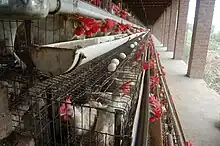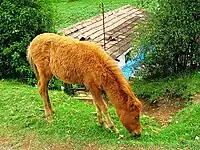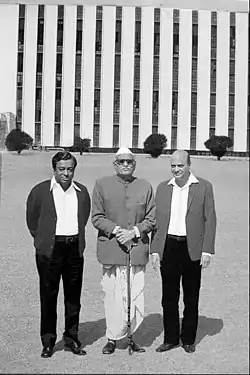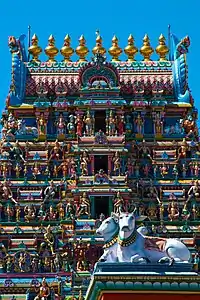| |||
Many farmers in India depend on animal husbandry for their livelihood. In addition to supplying milk, meat, eggs, wool, their castings (dung) and hides, animals, mainly bullocks, are the major source of power for both farmers and dairies. Thus, animal husbandry plays an important role in the rural economy. The gross value of output from this sector was 8,123 billion Rupees in FY 2015–16.[1]
Dairy
In FY 2019, India had approximately 192.5 million cattle. India also had 148.9 million goats, 109.9 million buffaloes, 74.3 million sheep, and 9.1 million pigs.[2] Milk production in FY 2018-19 was estimated to have reached 187.7 million tons (394 (gms/day/capita) (increased from 55.6 million tonnes, and 178 gm/day/capita in 1991–92),[3] and egg production had reached a level of 88.1 billion eggs.[4] India is second largest country in production of cow milk [5] and largest milk production country.[6]
Dairy farming provided supplementary employment and an additional source of income to many small and marginal farmers. The National Dairy Development Board was established in 1965 under the auspices of Operation Flood at Anand, in Gujarat, to promote, plan, and organize dairy development through cooperatives; to provide consultations; and to set up dairy plants, which were then turned over to the cooperatives. There were more than 63,000 Anand-style dairy cooperative societies with some 7.5 million members in the early 1990s. The milk produced and sold by these farmers brought ₹320 million (US$4.0 million) a day, or more than ₹10 trillion (US$125.2 billion) a year. The increase in milk production permitted India to end imports of powdered milk and milk-related products. In addition, 30,000 tons of powdered milk were exported annually to neighboring countries. There was about 50000 cows in India.[7]

Today, India has the world's largest dairy herd (composed of cows and buffaloes), at over 304 million strong,[8] and stands first in milk production, with 112.5 million tonnes of milk produced in 2009–2010.[8]
Operation Flood


White Revolution or Operation Flood, launched on 13 January 1970, was the world's largest dairy development program and a landmark project of India's National Dairy Development Board (NDDB).[9] It transformed India from a milk-deficient nation into the world's largest milk producer, surpassing the United States of America in 1998 with about 22.29 percent of global output in 2018.[10][11] Within 30 years, it doubled the milk available per person in India[12] and made dairy farming India's largest self-sustainable rural employment generator.[13] The program was launched to help farmers direct their own development, and to give them control of the resources they create.
Dr Verghese Kurien, the chairman and founder of Amul, was named the Chairman of NDDB by Prime Minister Lal Bahadur Shastri; Kurien thrust the program towards success and has since been recognized as its architect.[14] The making of skim milk powder out of buffalo milk, termed the Anand Pattern Experiment at Amul, was also instrumental to the program's success; the man who made this possible was Harichand Megha Dalaya, alongside Kurien.[15][16] It allowed Amul to compete successfully with cow milk-based suppliers such as Nestle.Poultry and meat
India is also the third-largest egg-producer in the world, producing over 95 billion eggs for the year 2018,[17] and fifth biggest producer of beef.[18] While the majority of India's animal products are consumed domestically, exports are growing. India is the top global exporter of buffalo meat, and is also the fourth largest exporter of soybean meal, an important ingredient in commercial feed for farmed animals.[19] In addition, India's leading poultry producers, including Suguna, Venky's, and the Amrit Group, are increasing sales to countries in other parts of Asia and the Middle East. International investment is also expanding.[19] In 2008, U.S.-based Tyson Foods acquired a 51 percent stake in Godrej, an Indian conglomerate that is a major producer of animal feeds and poultry, and the International Finance Corporation (IFC) has an equity stake in Suguna.[19] An estimated 200 million egg-laying hens are kept in battery cages, and more than half of the over two billion “meat” chickens produced each year are factory-farmed. Vertical integration and contract farming for poultry and eggs is also widespread. While the milk and cheese sectors still include many small-scale producers and cows and buffaloes in extensive systems the number of large, factory-style dairy operations is increasing.[20]
The main bottleneck to the growth of animal husbandry is availability of adequate fodder throughout the year. Fodder from the surplus states, are to be transported in the form of fodder pellets to deficit states to eliminate fodder scarcity.[21]
Livestock population in India by Species
| LIVESTOCK POPULATION IN INDIA BY SPECIES (MILLION NUMBERS)[2] | ||||||||||||||
|---|---|---|---|---|---|---|---|---|---|---|---|---|---|---|
| Species | 1951 | 1956 | 1961 | 1966 | 1972 | 1977 | 1982 | 1987 | 1992 | 1997 | 2003 | 2007 | 2012 | 2019 |
| Cattle | 155.3 | 158.7 | 175.6 | 176.2 | 178.3 | 180.0 | 192.5 | 199.7 | 204.6 | 198.9 | 185.2 | 199.1 | 190.9 | 192.5 |
| Adult Female Cattle | 54.4 | 47.3 | 51.0 | 51.8 | 53.4 | 54.6 | 59.2 | 62.1 | 64.4 | 64.4 | 64.5 | 73.0 | 76.7 | 81.4 |
| Buffalo | 43.4 | 44.9 | 51.2 | 53.0 | 57.4 | 62.0 | 69.8 | 76.0 | 84.2 | 89.9 | 97.9 | 105.3 | 108.7 | 109.9 |
| Adult Female Buffalo | 21.0 | 21.7 | 24.3 | 25.4 | 28.6 | 31.3 | 32.5 | 39.1 | 43.8 | 46.8 | 51.0 | 54.5 | 56.6 | 55.0 |
| Sheep | 39.1 | 39.3 | 40.2 | 42.4 | 40.0 | 41.0 | 48.8 | 45.7 | 50.8 | 57.5 | 61.5 | 71.6 | 65.1 | 74.3 |
| Goat | 47.2 | 55.4 | 60.9 | 64.6 | 67.5 | 75.6 | 95.3 | 110.2 | 115.3 | 122.7 | 124.4 | 140.5 | 135.2 | 148.9 |
| Horses and Ponies | 1.5 | 1.5 | 1.3 | 1.1 | 0.9 | 0.9 | 0.9 | 0.8 | 0.8 | 0.8 | 0.8 | 0.6 | 0.6 | 0.3 |
| Camels | 0.6 | 0.8 | 0.9 | 1.0 | 1.1 | 1.1 | 1.1 | 1.0 | 1.0 | 0.9 | 0.6 | 0.5 | 0.4 | 0.3 |
| Pigs | 4.4 | 4.9 | 5.2 | 5.0 | 6.9 | 7.6 | 10.1 | 10.6 | 12.8 | 13.3 | 13.5 | 11.1 | 10.3 | 9.1 |
| Donkeys | 1.3 | 1.1 | 1.1 | 1.1 | 1.0 | 1.0 | 1.0 | 1.0 | 1.0 | 0.9 | 0.7 | 0.4 | 0.3 | 0.1 |
| Yak | NC | NC | 0.0 | 0.0 | 0.0 | 0.1 | 0.1 | 0.0 | 0.1 | 0.1 | 0.1 | 0.1 | 0.1 | 0.1 |
Fisheries
See also
References
- ↑ "Basic Animal Husbandry and Fisheries Statistics 2017" (PDF).
- 1 2 "Live stock population in India every year".
- ↑ "Milk Production every year".
- ↑ "Eggs production every year" (PDF).
- ↑ "Cow milk production by country".
- ↑ "Milk production by country".
- ↑ Government of India. "Department of Animal Husbandry, Dairying & Fisheries". dahd.nic.in. Retrieved 2018-11-05.
- 1 2 "Annual Report" (PDF). Archived from the original (PDF) on 2013-07-21. Retrieved 2015-12-20.
- ↑ Katar Singh (8 June 1999). Rural Development: Principles, Policies and Management. ISBN 81-7036-773-5. Retrieved 24 April 2017.
- ↑ "India largest milk producing nation in 2010–11: hash". Hindustan Times. 20 December 2011. Archived from the original on 6 October 2012. Retrieved 9 September 2012.
- ↑ "Milk Production by country".
- ↑ Kurien, Verghese (2007). "India's Milk Revolution: Investing in Rural Producer Organizations". In Narayan, Deepa; Glinskaya, Elena (eds.). Ending Poverty in South Asia: Ideas that work. Washington D.C., USA: (The World Bank). p. 52. ISBN 978-0-8213-6876-3. Retrieved 11 September 2012.
- ↑ Pendleton, Andrew; Narayanan, Pradeep. "The white revolution : milk in India" (PDF). Taking liberties: poor people, free trade and trade justice. Christian Aid. p. 35. Retrieved 11 September 2012.
- ↑ "Father of white revolution Verghese Kurien dies". The Times of India. Archived from the original on 2 June 2013.
- ↑ Kurien, Verghese (2007). "India' s Milk Revolution: Investing in Rural Producer Organizations". In Narayan, Deepa; Glinskaya, Elena (eds.). Ending Poverty in South Asia: Ideas that work. Washington D.C., USA: (The World Bank). p. 47. ISBN 978-0-8213-6876-3. Retrieved 13 January 2021.
If there was one technological breakthrough that revolutionized India's organized dairy industry, it was the making of skim milk powder out of buffalo milk. The man who made this possible, and who had the foresight to defy the prevailing technical wisdom, was H. M. Dalaya. While the Kaira District Cooperative Milk Producers' Union is usually associated with its founder, Tribhuvandas Patel, it was Dalaya who provided the real technical backbone to the Amul organization.
- ↑ Kurien, Verghese (2007). "India' s Milk Revolution: Investing in Rural Producer Organizations". In Narayan, Deepa; Glinskaya, Elena (eds.). Ending Poverty in South Asia: Ideas that work. Washington D.C., USA: (The World Bank). p. 42. ISBN 978-0-8213-6876-3. Retrieved 13 September 2012.
- ↑ "Egg Production by country".
- ↑ "Beef production by country, 2020".
- 1 2 3 Mia MacDonald and Sangamithra Iyer (2010) Veg or Non Veg? India at the Crossroads, Policy Brief. Brighter Green, 1.brightergreen.org Archived June 6, 2011, at the Wayback Machine
- ↑ Justine Simon and Sangamithra Iyer (2010) Factory Farming of Chickens in India; Youtube Video
- ↑ "Fodder pellets out of paddy straw to tackle burning issue". Retrieved 24 January 2019.
External links
- Animal Husbandry Department, Government of Gujarat
- Animal Husbandry Department, Government of Maharashtra
- Salient Features of 19th Livestock Census

_in_Kalleshvara_temple_at_Bagali_1.JPG.webp)